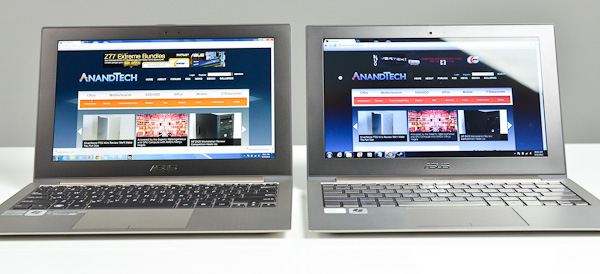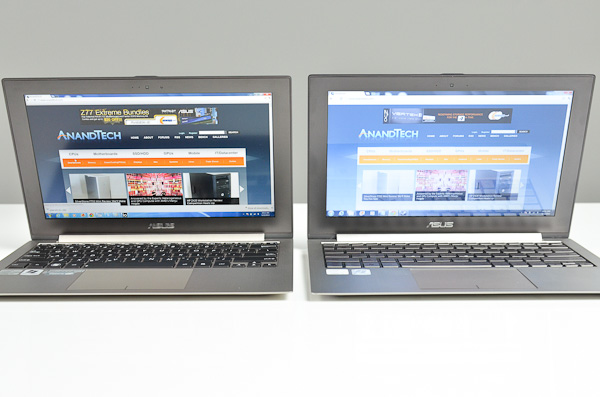ASUS Zenbook Prime (UX21A) Review: The First of the 2nd Gen Ultrabooks
by Anand Lal Shimpi on May 22, 2012 2:46 PM EST- Posted in
- Laptops
- CPUs
- Asus
- Ivy Bridge
- Zenbook
- Zenbook Prime
- Ultrabook
- Notebooks
The Display in Pictures
The star of the show is obviously ASUS' 1920 x 1080 IPS display. Contrast ratio, viewing angles and color reproduction are all significantly improved compared to the original Zenbook. White is a bit warmer than I'd like by default (6014K) but otherwise I really have no complaints about this panel. It's easily the best display I've ever seen ASUS use and arguably one of the best displays ever deployed in a notebook, much less one as small as the UX21. Before we get to the actual numbers, here are some shots of the Zenbook Prime compared to the lackluster Zenbook display:

Zenbook Prime (front) vs. Zenbook (back)

Zenbook Prime (left) vs. Zenbook (right)

Zenbook Prime (left) vs. Zenbook (right)

Zenbook Prime (left) vs. Zenbook (right)
Note just how much better the viewing angles are compared to the old Zenbook panel. ASUS clearly got it right this time.










192 Comments
View All Comments
techexperience - Wednesday, May 23, 2012 - link
So, if what I see is correct, (and anand always delivers).The only difference between the Zenbook Prime UX32 $799 and $999 is hardisk space? From 320 GB to 500 GB for $200?By the way great post, Anand, as usual.
http://techexperience.net
ReverendDC - Wednesday, May 23, 2012 - link
I believe that the UX32 is also a little thicker, and the non-DV versions have a dedicated GPU. The hard drives are also platter, not SSD.ReverendDC - Wednesday, May 23, 2012 - link
Sorry, the DV version comes with the dedicated GPU.Reflex - Wednesday, May 23, 2012 - link
Likely a faster CPU as well.UrQuan3 - Wednesday, May 23, 2012 - link
Darn, I went with a Samsung 9 last year and can't afford to replace it yet. 13.3 is too big for me and 1366x768 is too low res. 12" and 1080p would be nice. Looks like an acceptable color gamut as well.Let's not make excuses for poorly written GUIs. They should resize. Games don't have a problem with that.
I do home Microsoft catches their resolution-vs-size mistake on Metro. Last I checked, Metro used fixed sizes and used higher resolutions to put more on the screen instead of allowing app links to resize. They were assuming that high resolution screens are also physically bigger. Of course that would be awful on a small, high res screen. Anyone know if they changed that?
Stanly.ok - Wednesday, May 23, 2012 - link
I look at official Asus slides (particularly at the top of second page) and can't help but wonder ... what kind of marketer or manager made them at the last moment instead of giving this job to a professional?!name99 - Wednesday, May 23, 2012 - link
" In practice I saw a doubling of performance under the same conditions as the original Zenbook (80Mbps vs. ~40Mbps)."This seems really bad. You should have got a doubling from 40MHz 5GHz channels, and a doubling from 2x MIMO. Are you sure the laptop and the base station are both set up optimally (most importantly both are in Greenfield mode so they're not wasting a huge amount of time with g compatibility)?
My 3 yr old MBA gets around 13MB/s to an 18 month old AEBS, and I've seen the new MBAs get around 20MB/s to that AEBS, and I expect even better to the newest AEBS.
IntelUser2000 - Friday, May 25, 2012 - link
I think its the way Anand tests it. On and Macbook Air 2011 review he gets 117Mbps which is 14.6MB/s.dczyz - Wednesday, May 23, 2012 - link
Since we dont have a new MX in the small form factor yet, that UX32VD-DB71 maybe what I do with. Cant wait to see a review on it.agent2099 - Wednesday, May 23, 2012 - link
The main fault I see in this device is the VGA port. They should have included a mini display port to complement the HDMI port. That way you could run two high-resolution displays from the laptop. With my current laptop I have the HDMI out going to the television and I have the mini display port going to my 24 inch monitor.